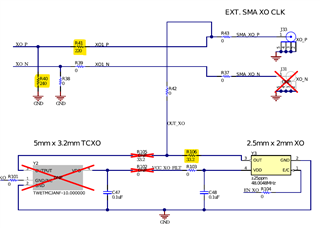Other Parts Discussed in Thread: LMK5B33216
Hello Expert,
Our customer is considering to design this part.
So there are some questions as below.
I want to get your feedback about each items.
1. If there is EVM or Design file (Schematic, PCB) or Design guide, please let me know.
I couldn't find them.
2. Is it possible to set OUT0/1, OUT2/3 to OUT0, OUT1, OUT2, OUT3 with different frequency outputs? Or is it the same frequency output?
Is it possible to output with separate frequencies? Are they tied together?
When I check register and block diagram, it seems to tied OUT0/1, OUT2/3 together.
3. When using two products for 16port output, is output clock skew control possible?
They want to remove clock skew on output.
4. About Ref. Clock:
Can I use only either DPLL or APPL? or Should I use all of them?
They think that reference clock is burden.
When I check block diagram, I think that both reference clock input is needed.
5. What's minimum output frequency of AC-LVDS?
There is no commented on the data sheet.
Our customer need min. 100khz.
Best regards,
Michael



